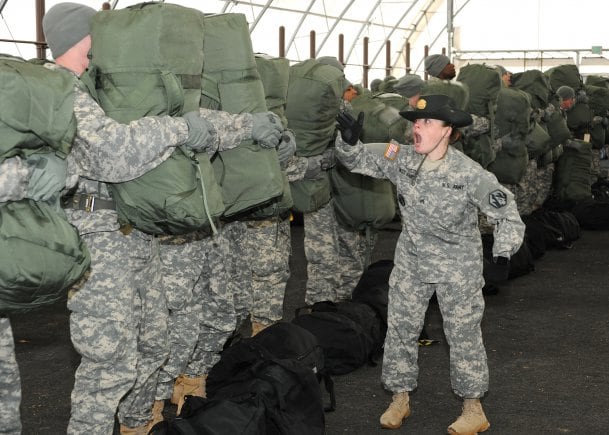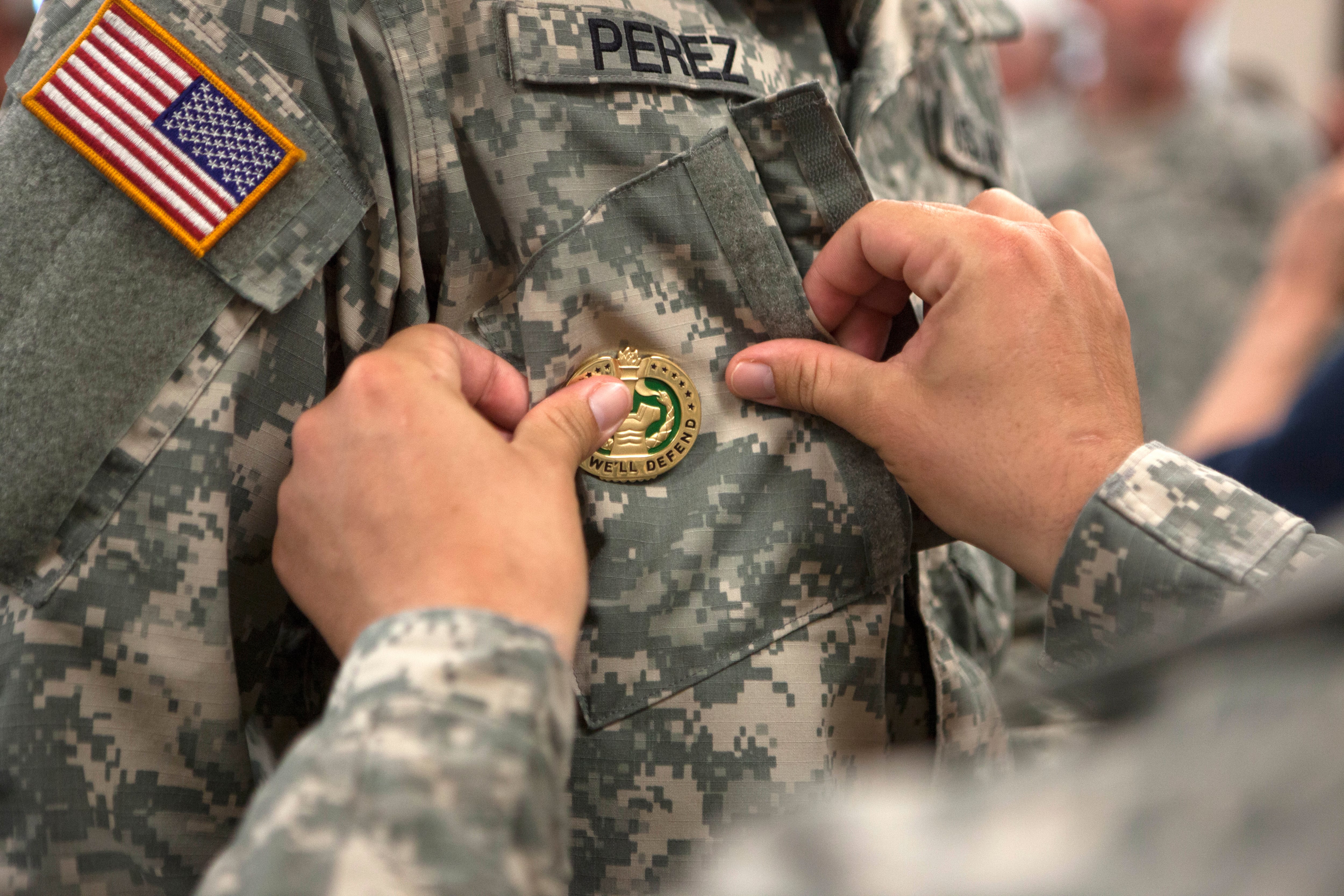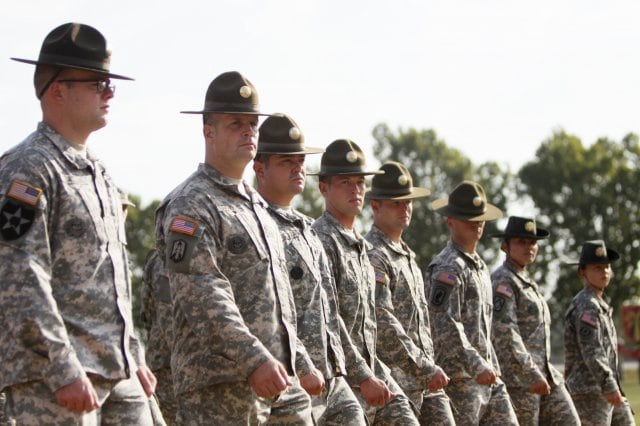In a push to instill more discipline among its newest soldiers, the Army is looking to its drill sergeants for help.
With their iconic hats and hard-nosed reputations, Army leaders are taking a serious look at whether drill sergeants should make a return to advanced individual training.
The move, if approved, would mark a huge reversal for the Army and mean an end to the service's lesser-known, underrated AIT platoon sergeants, who do much of the same work as drill sergeants without any of the perks.
The Army is moving closer to making a decision about whether to bring back drill sergeants to advanced individual training.
If the proposal is approved, the Army would replace its AIT platoon sergeants, marking a huge reversal for the service.
The Center for Initial Military Training is conducting research and will present a recommendation to Training and Doctrine Command senior leaders by early summer. If the proposal moves forward, any changes must be approved by senior Army leaders.
The Army's No. 1 priority is readiness,
"When you think about TRADOC soldiers, when we hand that soldier off to their first unit of assignment, there are three things we want them to be – fit, disciplined and well-trained," said said Command Sgt. Maj. David Davenport, the senior enlisted soldier for Training and Doctrine Command.
The Army loses about 12 percent of its trainees, and "we want to make sure they're the fittest, most disciplined, most well-trained soldiers," he said. "That's not to say AIT platoon sergeants aren't doing that, but this is another way to invest in our training."
Drill sergeants "are the epitome of a disciplinarian," Davenport said.
"As we think about the future and readiness, how do we make our soldiers more fit, more disciplined and better trained?" Davenport said. "Soldiers always remember their drill sergeants. They measure themselves against them."
The Army in 2007 made the switch to AIT platoon sergeants "to recognize that transition of the soldier from a total-control environment to lessening restrictions to prepare them to go to their first unit of assignment," Davenport said. The change did not affect one station unit training, which is run from start to finish by drill sergeants.
"It was a matter of trying to get them to associate authority with a figure other than the hat," said Command Sgt. Maj. Michael Gragg, the senior enlisted soldier for the Center for Initial Military Training. "But what we didn't realize and didn't take into account is the drill sergeant in the AIT environment is still working on that soldier."
Gragg also acknowledged the Army didn't give AIT platoon sergeants "all the tools that they needed to be as successful as they could be."
"The same individuals who are AIT platoon sergeants are the same people who would be drill sergeants," he said. "It's not about them being ineffective, it's about increasing their effectiveness."

The Army is studying a plan to put drill sergeants back in advanced individual training. Here, Sgt. Lori Singer-Barre, a drill sergeant with 1st Battalion, 48th Infantry Regiment, emphasizes instructions during integration Saturday.
Photo Credit: Stephen Standifird/Army
The move to AIT platoon sergeants also was meant to introduce new soldiers to the role of noncommissioned officers as they learn the technical skills required for their first assignment in the Army, Davenport said.
"It's working," he said. "I just think that to improve the morale of the AIT platoon sergeants and to recognize the hard work they are doing, that they should be parallel to that of a drill sergeant."
Those who have served as AIT platoon sergeants praise it as a key broadening assignment that gives NCOs leadership experience and a chance to mentor young soldiers. But the job also has gained a reputation for hard work with long hours and no incentives. For example, AIT platoon sergeants wear a patrol cap, not the distinctive campaign hat worn by drill sergeants. They also do not receive Special Duty Assignment Pay; drill sergeants earn an extra $300 a month.
"Our AIT platoon sergeants have done nothing wrong," Davenport said. "But I hear them. They want badges, they want hats, they want SDAP. If they're selected through the same process as drill sergeants, and they go to Drill Sergeant School, it seems to me we're training them like drill sergeants as well, so why not just make them drill sergeants?"
Making the switch also gives the Army more flexibility when it comes to manning these critical positions, Davenport said.
"If they're all drill sergeants, if they want to do a third year as a drill sergeant, instead of doing basic training again, maybe we can move them to AIT or vice versa," he said.
The Center for Initial Military Training's cost-benefit analysis has already determined that making the switch is attainable and feasible, Gragg said, adding that the Army has enough personnel in its ranks who meet the criteria to become drill sergeants.
"The question is, is it sustainable?" he said. "The AIT platoon sergeants are doing an excellent job, but they aren't compensated with any type of special duty pay. If we're able to put drill sergeants into the AIT environment, it comes with some associated costs."
The biggest expense will be Special Duty Assignment Pay, which amounts to $300 a month per drill sergeant, Gragg said.
The Army has more than 2,100 drill sergeants and more than 650 AIT platoon sergeants on duty.
If the Army puts drill sergeants back in AIT, Gragg said he expects the number of NCOs in AIT will increase slightly.
A typical drill sergeant is in charge of about 20 soldiers, while the typical student load for an AIT platoon sergeant is 40, he said.
"If we put drill sergeants back in AIT, we would focus on getting the ratio back to 1 to 20, so we would have an increase in the number of individuals in the AIT environment," Gragg said.

Drill sergeant leader Matthew Torres pins Staff Sgt. Manuel Perez III with his drill sergeant badge during a ceremony at the US Army Drill Sergeant School in Fort Jackson, South Carolina, on Tuesday, August 26, 2014. This year marks the 50th anniversary of the school. (Mike Morones/Staff)
Photo Credit: Mike Morones/Staff
There also will be other AIT locations where the Army may opt to retain platoon sergeants, "where it's just not feasible to have a drill sergeant there," he said.
"We may look at programs where we'd like to remain with some type of different variant of cadre than a drill sergeant because of the length of the course or complexity of the course or status of the students in the course," he said. "We can't go into it with a one-size-fits-all."
The move to possibly return drill sergeants to AIT was not prompted by platoon sergeants' performance, Gragg said.
"Our AIT platoon sergeants are doing an outstanding job with the tools and skills that they have," he said. "The problem that we do have is that right now the generation we have coming in is not as disciplined as we would like them to be, so we have to provide them with discipline over a longer period of time."
When asked why AIT platoon sergeants aren't just given a hat and a badge, Gragg said: "Then why not just make them drill sergeants?"
"The drill sergeant is a symbol of the master trainer and master disciplinarian that transcends our basic combat training locations, that transcends our military into our civilian world," he said.
Gragg said he's hearing "different types" of feedback from AIT platoon sergeants across the force.
"There's some miscommunication out there where they think bringing the drill sergeant back is a hit or slight against the AIT platoon sergeant," he said. "It's not about the AIT platoon sergeant as an individual. It's about the authority embodied in a drill sergeant. That drill sergeant is able to influence and maximize the discipline in an organization."
The requirements for drill sergeant and AIT platoon sergeant are almost identical, Gragg said. The key difference is sergeants can be drill sergeants, while the Army seeks staff sergeants with at least two years' time in grade to fill AIT platoon sergeant positions.
"It's actually a little bit tougher for us to find and get the right people to be AIT platoon sergeants," Gragg said. "They're actually vetted a little bit tougher than the drill sergeants."

Drill sergeants in 434th Field Artillery Brigade march in formation across Polo Field, Fort Sill, Okla., for the 50th anniversary celebration of the U.S. Army Drill Sergeant School.
Photo Credit: Marie Berberea/Army
The Drill Sergeant Academy trains both drill sergeants and AIT platoon sergeants, said Command Sgt. Maj. Charles Gilmer, the commandant.
Drill sergeant candidates must complete a nine-week course. AIT platoon sergeant candidates complete a six-week course before receiving two weeks of Master Resiliency Training, he said.
"Drill sergeants are our first priority fill," Gilmer said. "An AIT platoon sergeant … is still a critical position, but it's still not widely known across the force."
If the Army decides to put drill sergeants back in AIT, the academy is already working on "a couple courses of action," Gilmer said. He declined to provide any details because nothing has been finalized or approved.
"We'll be able to handle the throughput and transition, and we'll phase it so the timing works," he said.
Despite their similar training and requirements, once on the job, there is a big difference between drill sergeants and AIT platoon sergeants, said Lt. Col. Michael Anders, commander of 1st Battalion, 78th Field Artillery Regiment, which is an AIT training battalion at Fort Sill, Oklahoma.
Drill sergeants serve as primary instructors, responsible for teaching and instructing new soldiers every day, he said. AIT platoon sergeants, on the other hand, are primarily responsible for leading and taking care of their soldiers and preparing them for their first unit of assignment.
About 6,000 trainees come through 1st Battalion every year, Anders said. There are currently 23 AIT platoon sergeants assigned to take care of the 700 soldiers in the battalion.
Replacing AIT platoon sergeants with drill sergeants "I don't think would change the job any," Anders said. "It's just going to give them a hat and a badge and extra money. I don't see how it'll increase the ability to instill discipline."
Michelle Tan is the editor of Army Times and Air Force Times. She has covered the military for Military Times since 2005, and has embedded with U.S. troops in Iraq, Afghanistan, Kuwait, Haiti, Gabon and the Horn of Africa.





